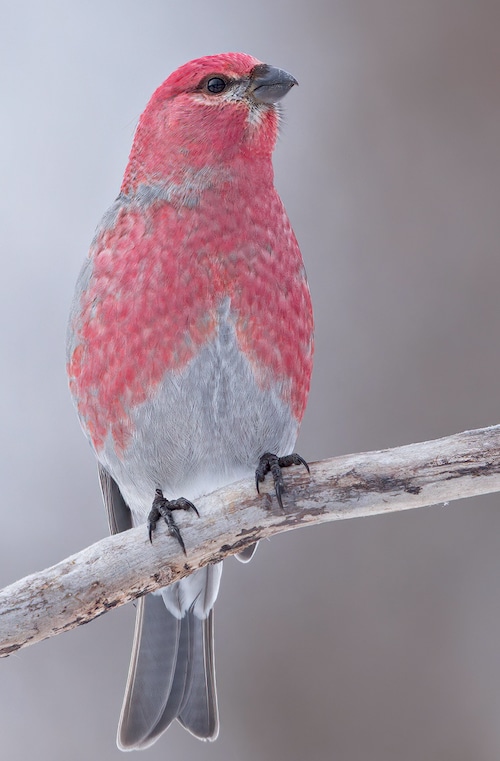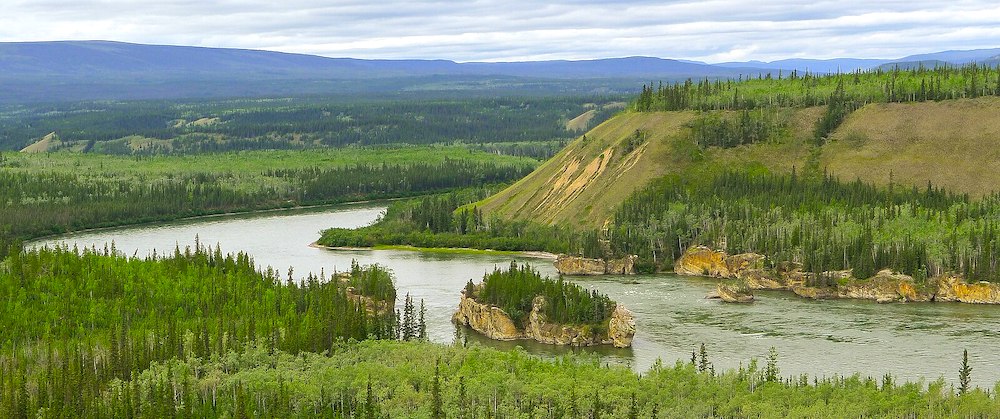Yukon

Yukon is the smallest and westernmost of Canada’s three territories. It is the third-least populated province or territory in Canada, with a population of around 45,000. However, Whitehorse, the territorial capital, is the largest settlement in any of the three territories. The territory is the approximate shape of a right-angled triangle, bordering the US state of Alaska to the west and northwest for 1,210 kilometres (752 miles), the Northwest Territories to the east and British Columbia to the south. Its northern coast is on the Beaufort Sea. Its ragged eastern boundary mostly follows the divide between the Yukon Basin and the Mackenzie River drainage basin to the east in the Mackenzie mountains.
Most of the territory is in the watershed of its namesake, the Yukon River. The southern Yukon is dotted with a large number of large, long and narrow glacier-fed alpine lakes, most of which flow into the Yukon River system. The larger lakes include Teslin Lake, Atlin Lake, Tagish Lake, Marsh Lake, Lake Laberge, Kusawa Lake and Kluane Lake. Bennett Lake on the Klondike Gold Rush trail is a lake flowing into Nares Lake, with the greater part of its area within Yukon. Other watersheds in the territory include the Mackenzie River, the Peel Watershed and the Alsek–Tatshenshini, and a number of rivers flowing directly into the Beaufort Sea. The two main Yukon rivers flowing into the Mackenzie in the Northwest Territories are the Liard River in the southeast and the Peel River and its tributaries in the northeast. At just under 6,000 m Yukon’s Mount Logan, in Kluane National Park and Reserve, is the highest mountain in Canada and the second-highest on the North American continent (after Denali in Alaska). Other national parks include Ivvavik National Park and Vuntut National Park in the north. A second UNESCO World Heritage Site, Tr’ondëk-Klondike World Heritage Site.

Five Finger Rapids, Yukon River – ©Bo Mertz CC BY-SA 2.0 via Wikimedia Commons
Most of the Yukon has a subarctic climate, characterised by long, cold winters and brief, warm summers. The coastal area along the Arctic Ocean has a tundra climate. While the average winter temperature in the Yukon is mild by Canadian arctic standards, no other place in North America gets as cold as the Yukon during extreme cold snaps. The temperature has dropped down to −60 °C three times. The most extreme cold snap occurred in February 1947 when the abandoned town of Snag dropped down to −63.0 °C. Unlike most of Canada where the most extreme heat waves occur in July, August, and even September, the Yukon’s extreme heat tends to occur in June and even May. The Yukon has recorded 36 °C three times.
Notable widespread tree species within the Yukon are the black spruce and white spruce. Many trees are stunted because of the short growing season and severe climate.
Birding The Yukon
The Yukon is a land of stunning scenery, productive ecosystems and truly remarkable wilderness. This extraordinary natural world is home to diverse communities of birds. A total of 348 species have been documented in the Yukon with breeding confirmed for 188 species. Diverse habitats include wetlands, expansive boreal forest, alpine and arctic tundra, and the marine waters of the North Coast. This natural mosaic, with its mix of southern and northern species makes the Yukon an attractive destination for birdwatchers and naturalists.
Many first time visitors are surprised to see southern species like Killdeer, American Robin, and Red-winged Blackbird. However, their first encounters with Pacific Diver (Loon), Northern Goshawk, Long-tailed Skua (Jaeger), Northern Wheatear, Willow Ptarmigan, Spruce Grouse, Arctic Tern, Gray Jay, Boreal Chickadee, and the ever-present Common Raven reminds them that they have definitely arrived in the North.
The Yukon is a land of rich environments and pristine wilderness. The birds, wildlife and ecosystems are sensitive and must be observed and explored with respect. In this way, the Yukon will continue to reward us with unparalleled natural experiences.
-
Number of bird species: 348
(As at May 2024)Provincial Bird - Raven Corvus Corax Principalis
-
Avibase
PDF ChecklistThis checklist includes all bird species found in Yukon , based on the best information available at this time. It is based on a wide variety of sources that I collated over many years. I am pleased to offer these checklists as a service to birdwatchers. If you find any error, please do not hesitate to report them. -
Wikipedia
Annotated ListThis list of birds of Yukon includes species documented in the Canadian territory of Yukon. Unless otherwise noted, the list is that of the Yukon Bird Club (YBC). As of 2021, there were 348 species included in that list. Of them, 58 are casual and 60 are accidental; both terms are defined below. Four have been introduced to Yukon or elsewhere in North America. -
Yukon Government
PDF ChecklistThe Yukon is a land of stunning scenery, diverse ecosystems , and truly remarkable wilderness. This extraordinary natural world is home to some unique communities of birds. This checklist summarizes the occurrence and breeding status of 32 9 species which have been documented in the Yukon. Breeding has been confirmed for 19 5 species, and 43 species occur annually in winter. Distribution codes indicate species which are typically found in a limited range in the Yukon.
-
Birds of the Yukon Territory
| Edited by Pamela H Sinclair, Wendy A Nixon, Nancy L Hughes & Cameron D Eckert | University of British Columbia | 2003 | Hardback | 596 pages, 600 colour photos, 223 b/w illustrations, 235 maps | Out of Print | ISBN: 9780774810128 Buy this book from NHBS.com
-
Birding Yukon
Facebook PageBirding Yukon is a place birders and bird watchers visiting the Yukon can reach out to local bird guides for information and guided excursions. -
Yukon Bird Club
WebsiteThe Yukon Bird Club is a non-profit, charitable organization dedicated to promoting awareness, appreciation, and conservation of Yukon birds and their habitats. Regular field trips led by skilled and enthusiastic birders explore some of the Yukon's best birding areas. Each winter an evening seminar series covers a wide range of interests including local research projects, bird identification, birding adventures and Yukon biodiversity. All are welcome at field trips and events! We are based in Whitehorse, Yukon, but have members from many communities throughout Yukon as well as some from further afield.
-
MBS Old Crow Flats
InformationSatellite ViewMore than 100 bird species have been recorded on the Flats, including at least 21 species of waterfowl. The area is important as a breeding and moulting ground to some 500,000 waterfowl including ducks, swans, geese, three species of loon Gavia spp. and a variety of other waterbirds. Banding studies have shown these birds to be associated with all four North American Flyways. Waterfowl are more concentrated here than at other locations in the north. -
NP Ivvavik
InformationSatellite ViewThe park protects a portion of the calving grounds of the Porcupine caribou herd and represents the Northern Yukon and Mackenzie Delta natural regions. -
NP Kluane
InformationSatellite ViewThis park, in the southwest corner of the Yukon, has Canada's highest peak, Mount Logan, and some of the most extensive icefields outside the polar region. The landscape includes mountain lakes, alpine meadows, tundra and swift cold rivers… -
NP Vuntut
InformationSatellite ViewVuntut represents one of the Northern Yukon Natural Regions in Canada. -
NWA Nisutlin River Delta
WebpageSatellite ViewThe Nisutlin River Delta National Wildlife Area (NWA) is southern Yukon's most important fall staging site for migratory waterbirds. This 5,483 hectares (ha) NWA includes the delta at the mouth of the Nisutlin River which is the most extensive inland freshwater delta in the Yukon. Thousands of ducks, geese, and swans feed along the delta each year, along with hundreds of shorebirds. The delta is particularly important for migrating waterbirds in the fall because suitable feeding areas in the region are limited by high water levels. The NWA also provides excellent habitat for moose, and habitat for some species assessed as Threatened or Special Concern by the Committee on the Status of Endangered Wildlife in Canada (COSEWIC). -
Yukon National Parks
WebpageSatellite ViewYukon territorial parks and other conservation areas
-
Nahanni River Tours
Tour OperatorFor nearly two decades Neil Hartling and Barry Beales of Nahanni River Adventures and Whitewolf Expeditions have fine tuned the most extensive offerings of the best of the north. In 1997 the two companies joined together to capitalise on the strengths of each outfit. The resulting selection has been referred to as the life list of northern rivers - all must do's. -
Northern Wildlife Safaris
Tour OperatorNorthern Wildlife Safaris offers severall light hiking and vehicle based safaris to bring both professional and amateur wildlife photographers up close to some of the wild animals of the north…
-
2007 [07 July] - Blake Maybank
ReportSince there are very few birding trip reports from the Yukon and area, I've decided to offer this fairly thorough account… -
2016 [09 September] - Stefan Schlick
PDF ReportThe main goal for this birding trip was to learn calls and habitat for some of the northern breeders (including the eastern birds), better understand the range of some species and – of course – take in the scenery of the epic Canadian north. It was also very interesting to study subspecies (Junco, Fox Sparrow, Merlin, …) and to be in hybridization zones (sapsuckers).
-
Best Bird Watching Trails in Yukon
WebpageExplore the most popular bird watching trails in Yukon with hand-curated trail maps and driving directions as well as detailed reviews and photos from hikers, campers and nature lovers like you. -
Birds of The Yukon
WebpageThe Yukon has a surprisingly long and rich history of bird watching despite it’s age and the small number of bird-lovers/naturalists who have been able call it home over the years.
-
Yukopn Bird Club
BLOGAwareness, Appreciation and Conservation of Yukon Birds and their Habitats

